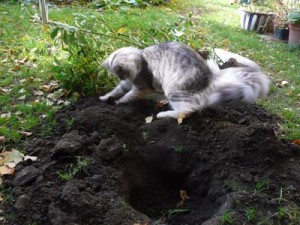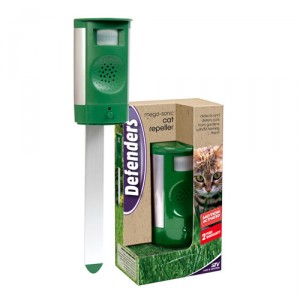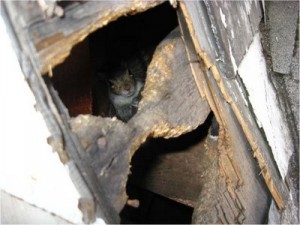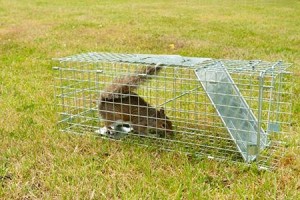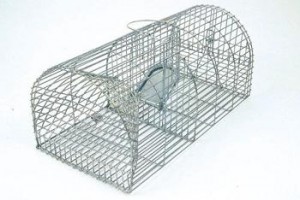How To Keep Cats Away
I am often asked how to keep cats away from yards. Cats are unpredictable, so there are few sure-fire cat repellents. But below I consider some of the best approaches known to keep cats away from yards. Broadly speaking, we can label all of these diverse approaches as “cat repellents,” since they are all designed to repel unwanted feline intruders from a specific area. But I’ll also provide an example of the commercial products more narrowly associated with the label, “cat repellents,” namely, products that come in a can and are sprinkled on the ground to keep cats away.
A Cat Repellent Before You Even Begin
If you haven’t planted a flower bed yet, but you anticipate having trouble keeping cats out of your yard, be aware that one of the most effective cat repellents is readily available at most any hardware store: chicken wire.
No, I’m not going to suggest you erect a chicken-wire fence. Instead, lay chicken wire down on top of your soil (or mulch, if you’re using mulch in the bed), across the planting bed, before you plant. Why? Because cats disdain walking on chicken wire. Using wire cutters, you’ll be able to open up pockets in the chicken wire sufficiently large for installing your plants.
Cat Repellents After the Fact: 10 Ways to Keep Cats Away From Yards
But what if it’s too late for the chicken-wire option? Not to worry. The ten cat repellents on which I focus below are all intended for existing garden beds. While on the subject of wire, I’ll begin with electric wire fences.
1. Like rabbits, cats can be kept away humanely with the Mr. McGregor Fence. This fence is so safe that even Responsible Consumer.Net recommends it.
Water: The Ultimate Cat Repellent?
Sometimes, to keep cats away from a yard, you have to think like a cat. Put yourself in the cat’s place. Observe cat behaviour. For instance, they’re pretty fussy creatures, aren’t they?
One of the things cats are fussy about is getting wet. Water is “kryptonite for cats.” Getting wet seems to be almost a phobia for them. Use that phobia to your advantage in trying to keep cats away from yards.
2. When you catch cats in the forbidden area, you can try hosing them down with a Super Soaker or similar water gun. Such action may reinforce the notion that they are unwanted in your planting bed.
3. But if that doesn’t work, you can go hi-tech. Devices such as Scarecrow Sprinklers detect an intruder’s presence and fire a blast of water at it.
Thinking like a cat again, another thing we can say cats are fussy about is how something smells. You can use feline fastidiousness to keep cats away from your yard in a number of ways:
Commercial Cat Repellents
4. One of the commercial cat repellents available is a powder called, “Shake-Away.” Shake-Away bears the scent of the urine of predators that cats fear, namely, the coyote, the fox and the bobcat. This commercial cat repellent comes in a granular form, which you simply sprinkle around the problem area. The product is advertised as being organic, making it an acceptable option to use around children and pets. Nor will it harm your plants.
Plants That Are Cat Repellents
5. Some plants give off smells that cats dislike. One such plant, Coleus canina, goes by the common name, “scaredy cat plant.” As the second term in the Latin name indicates (think “canine”), it is also effective if you have trouble landscaping with dogs. Other plants often recommended for keeping cats away from yards are:
• rue,
• lavender, which deer pests also dislike
• pennyroyal
Other Substances That Double as Cat Repellents
6. Try sprinkling “stinky” substances around the problem area, including:
• dried-blood (“blood meal”) fertilizer
• mothballs (drop them into a can or jar, cover, and make a few holes in the cover)
• cayenne pepper flakes (but see below)
Note that mothballs are toxic, thus the recommendation that you use them in a covered can or jar. Avoid even this usage if small children will be in the yard and could, potentially, open such a can or jar. Note also that some people caution against using cayenne pepper in this fashion, saying it can be harmful to cats. So if you’re an animal lover or tend to be on the cautious side, then save the cayenne pepper to flavour your food!
http://landscaping.about.com/od/pestcontrol/a/cat_repellents.htm
Still “thinking like a cat” to figure out how to keep cats out of gardens, let’s consider something else cats are fussy about: the texture of what they step on. After all, it’s not for nothing we have the expression, “pussyfooting around.” I already mentioned chicken wire in this context.
How to Keep Cats Out of Your Garden: No “Pussyfooting Around”
7. Cats don’t like to walk on bristly material. So in mulching the problem bed, include something on which the refined paws of cats will fear to tread, such as sharp-edged pine cones.
8. Another mulch-related idea is to use stone mulch. It may not be the most attractive mulch for your particular bed, but cats prefer to poop in loose dirt. Cats usually won’t bother with an area mulched in stone. They’d rather be “pussyfooting around” where the digging’s easier on their paws.
How to Keep Cats Out of Your Garden: Striking a Compromise
As in landscaping with dogs, sometimes the path of least resistance provides the best solution to your problem. Strike a compromise with your cat by planting a separate bed of catnip plants, in another part of the yard. Not all cats go nuts over catnip plants, but those who do may come to view their “catnip patch” as their own private sanctuary.
9. Better still, make a sandbox just for cats and keep it in close proximity to the catnip plants. Chances are that the sandbox will serve as a magnet for cat poop. Sure, you’ll have to clean up the cat poop afterwards. But at least you’ll know where it is.
How to Keep Cats Out of Your Garden: Hi-Tech to the Rescue, Again
Hi-tech approaches to keeping cats out of gardens don’t stop with the motion-activated sprinklers mentioned. You can also keep cats out of gardens using ultrasound.
10. Simple to install, this sonic cat scarer can be set up within seconds. Effective in all weather conditions, it also provides 50% more coverage than other cat repellers on the market. One unit can protect a garden of up to 40 feet in length. For larger gardens the repeller can be used solely to target problem areas or in multiples to cover the entire area. The ultrasonic frequency emitted is inaudible to humans, so will not hinder your enjoyment of your outdoor areas.
Grey Squirrels Cause Serious Problems
Their scientific name is Sciurus carolinensis.
They were introduced from USA /Canada to approximately 30 sites in England, Scotland and Wales from 1876–1930.
Grey squirrels do not appear to be susceptible to Squirrel pox virus, but may carry and transmit it.
Grey varieties eat seeds, buds, flowers, shoots, nuts, berries and fruit from many trees and shrubs. They also eat fungi and insects, and occasionally birds’ eggs and fledglings. They will strip bark from trees during the summer months.
- They store nuts in the ground in the autumn, but do not remember where they store them. They rely on scent to find them.
- The male and female are usually called a buck and doe.
- They can be right- or left-handed!
- They molt their coat twice a year, once after winter and then in the late summer before the weather gets colder again.
- They do not have ear tufts.
- They can live to 5-7 years of age.
- They have four fingers and five toes.
- The upper fur is mainly grey with mid-brown along the upper back, and chestnut over the flanks, limbs and feet. Their underside is white. The tail hairs are grey, banded with brown and black and a white fringe.
- They weigh 450-650g.
- Their body is 24–26cm long and their tail is 19-24cm in length.
- They live high in trees in a nest made from twigs, leaves and moss. This is called a drey. More recently they have taken to living and nesting in loft spaces.
- The drey may be in a hole in the tree or set against the trunk and branches.
- Pregnancy lasts 44 days and their young are called kittens.
- Kittens are born with their eyes closed, without teeth and with no hair. After about seven weeks they look just like small versions of their parents and are ready to leave the drey.
- There are generally 2 litters a year (rarely 3), with 3–7 kittens in each litter
- Average densities in broad leaf areas are approximately 8-18 greys per hectare, and 0.1-1 per hectare in coniferous areas.
- They do not hibernate over winter, but may be less active when weather conditions are bad.
- They can hang upside down!
- They can swim
Squirrel pox is a fatal disease currently affecting red squirrel populations in some areas. Epidemics of disease caused by an unidentified agent have been described in Britain since early last century. In the 1970’s Ian Keymer investigated causes of diseased red varieties in East Anglia and as a result of his work a pox virus was identified in eyelid lesions (Scott, Keymer & Labram, 1981). It is now certain that this pox virus is a significant factor in the decline
of the red squirrel population in the UK.
The origin of squirrel pox virus in red squirrels is the introduced American grey. Research shows that the antibodies to the virus are very common in many grey squirrel populations in England & Wales (although not in Scotland until recently – 13 greys have tested positive for antibodies since June 2005) but only one case of disease has been found in a grey.
Red squirrels are not found to carry the antibodies unless they are already succumbing to squirrel pox disease. It is therefore thought that grey squirrels act as a reservoir host for the virus. All wild-living red squirrels observed to be affected by squirrel pox virus appear to die within 2 weeks of becoming infected.
As yet we do not know the route of transmission. Possibilities include transfer via saliva or scent marking secretions at feeding or scent-marking sites, or perhaps by ectoparasites (fleas, lice, ticks and mites) which may transfer from animal to animal in the dreys. The virus is unlikely to spread through the air if it behaves like other pox viruses. Further research in this area is needed.
Live cage traps, either single or multi catch, involve attracting squirrels to a trap with a bait (food). These can be used in the same way as spring traps. Set at the base of trees and covered with logs. It is best to pre bait these traps, leaving the entrances open so that the squirrels can run freely for a few days before setting.
The density of traps required depends on whether single or multi- capture traps are used.
Single traps should be spaced 75-125m apart, multi traps 150-200m apart, equating to one trap per ha. In areas where it is difficult to draw squirrels to the ground – for example, pine mixtures, or where traps are disturbed by badgers, deer or wild boar – it may be necessary to site traps on platforms on the trees.
Captured squirrels should be humanely destroyed by guiding them to one end of the trap, where they can be killed with an air rifle or the traps can be emptied into a sack and the squirrels dispatched through a swift, heavy blow to the head. Non target species should be released immediately.
Information About Rat Traps
Rat traps are to catch rats
Rats are suspicious of new objects and rat traps with only one entrance. If they see other rats have been trapped they may also avoid the trap. Traps which do not address these issues are likely to catch only young, inexperienced rats, not the older ones.
Spring traps designed for rats are powerful enough to break a rat’s neck or spine. They may break human fingers as well, whereas an ordinary spring-based mousetrap is very unlikely to break a human finger. Rat spring traps may not be sensitive enough to spring when a mouse takes the bait.
http://en.wikipedia.org/wiki/Rat_trap
Types of traps
A rat cage trap is a metal cage box-shaped device that is designed primarily to catch rats without killing them. Food bait (not poisoned) is put in the cage trap. When an animal enters the cage and moves toward the bait, the mechanism triggers and closes a door over the entry point. The animal is caught alive and without injury. The animal can be transported and released elsewhere or subsequently killed.
Glue traps are non-poisonous sticky glue spread over card boards and the like and kept in places rats frequent, which gets them stuck to it when they pass over it. A bait may also be placed on the cardboard to attract the rats.
Another form of non-lethal trap is one where the wires it is constructed of are cut and formed into a funnel shape directed into the body of the cage. This design is usually dome shaped with the funnel at the crown. Rats are extremely flexible and can push through the narrower opening into the cage, but cannot escape due to the ends of the wires poking them in the face . The advantage of this design is that it can catch more than one rat at a setting.
Other types of traps are designed to kill the animal.
Electronic traps detect the presence of a rodent via metal plates on the floor of the trap, then deliver a lethal dose of high voltage electricity stepped up from batteries to several thousand volts. Some brands offer remote indication to tell you when the trap has operated.
Metal Rat Traps
The full metal construction of the trap is robust and yet easy to set, the trap with its solid base together with a powerful mechanism.
The strength of the trap and results seen from it, far exceed that of the wooden or plastic alternatives.
Rats and How to Use Rat Poison to Control Them
Rodent baits, also known as mouse poison or rat poison offer an economical and efficient approach to controlling rodent populations. The poison come in either pellets or blocks.
Bait packets are useful as they keep the poison away from you while placing the poison in the proper location. Also, rodents must gnaw through the covering, therefore you can determine whether there was rodent activity involved with the bait.
Pellet baits and place packs are prone to being carried away and stored in different locations. For this reason, the baits can come in contact with pets and children. Placing the packs in nests or burrows is encouraged in order to control large populations of rodents.
Block baits come in a unique shape that’s designed to provide rodents with an attractive gnawing item. Typically, block baits are nailed to a piece of wood in order to prevent it from being carried away and allow you to monitor whether it has been gnawed or is still intact.
In most cases, it makes little sense to evenly place baits in a room if the rodent activity is located in one or two specific areas. When used properly, mouse poison should not harm pets or children, but it is important to remember that it could harm wildlife and children. Be sure to take extra precautions against accidental poisons. Also, remember, poisoned rodents may die anywhere; they may die in an inconvenient location. However, most of the time, poisoned rodents succumb to the poison and die in their nests.
The poison that is used by professionals is Bromadiolone as it has a higher toxicity to rodents than many other anticoagulants. It is perfect for eradicating rat infestations in both indoor and outdoor domestic situations such as in gardens, sheds, lofts or roof spaces, or beneath kitchen units, as well as being suitable for use in commercial contexts such as in warehouses, factories, restaurants, food premises, and farms.
|
Application: |
Recommend changing bait out every 40-60 days if not eaten. Very cold or warm temperatures will mold or sour the bait faster. Apply bait in locations out of reach of children, pets, domestic animals and non target wildlife, or in tamper-resistant bait stations. |
|
Pet safe: |
Used in tamper resistant bait stations or areas inaccessible to non target animals and children. |
|
Coverage Area: |
All bait placements must be inside or within 50 feet of buildings. |
|
Special Features: |
Multiple edges on these rat poison blocks appeal to a rodent’s desire to gnaw, are made with food-grade ingredients and small amounts of paraffin for a highly palatable bait which holds up well, particularly in adverse or moist conditions, superior rodent acceptance and control including control of Warfarin-resistant rats. |
|
Time to Kill: |
Single feed, 1-5 days |
https://www.domyownpestcontrol.com/contrac-blox-rodenticide-p-80.html
Gardens under attack after slug increase
Slug numbers are expected to keep growing if we do not see a spout of dry and hot weather this summer.
 After the unpredicted weather that has been seen across England and Scotland it wasn’t just the rivers and lakes that benefited from the amount of rainfall received, but the slug population has boomed and has supposedly doubled due to the perfect weather conditions that they like. While this is good news for the birds who thoroughly enjoy snacking on a slimy slug, all farmers are expected to see crop shortages this year after the slug numbers are expected to have doubled after a frost free winter and mild and wet spring. So for all potato farmers and potato consumers expect to see numbers fall and prices rise this year thanks to our unwelcome slimy pests.
After the unpredicted weather that has been seen across England and Scotland it wasn’t just the rivers and lakes that benefited from the amount of rainfall received, but the slug population has boomed and has supposedly doubled due to the perfect weather conditions that they like. While this is good news for the birds who thoroughly enjoy snacking on a slimy slug, all farmers are expected to see crop shortages this year after the slug numbers are expected to have doubled after a frost free winter and mild and wet spring. So for all potato farmers and potato consumers expect to see numbers fall and prices rise this year thanks to our unwelcome slimy pests.
B&Q have said that their sales in slug pellets have already risen by 44% this year compared to last and stores in Scotland have said to have sold double the amount of slug pellets this year. So what to do to protect our gardens?
Lay gravel or egg shell around your prize plants, this will hurt the slugs and will not travel across it. Gather some margarine tubs or tuna tins and bury them a little way into the soil, now poor some cheap and fizzy beer into them, the idea is that the slugs love the smell of beer and will fall into the containers and drown. Another tip is not to leave your grass cutting on the lawn, rake it up and put it in the green bin or take to your local tip, slugs find cut grass a perfect habitat. And lastly, pop out some bird feeders and encourage the birds into your garden, they will find the slugs and do the cleaning up for you.
A Hedgehog is your Gardens best friend
Are you forever trying to beat the slugs to your lettuces each year? Perhaps you’re fed up of littering your flower beds in slug pellets and sprinkling gravel around your pots? There is a solution to this and it does not need to cost you money, you are doing something for the wildlife around you and the certain pest controller is very lovely to see. Have you guessed it yet? It is the Hedgehog.
Hedgehogs make great pest controllers and can cure your garden slug and snail problem in just three months and can consume up to 200 grams a night of other insects and bugs that damage plants. So if you play your part to keep them happy, they will keep you happy.
So what is the first thing to do to encourage a hedgehog into your garden? I am afraid the key thing to attracting a hedgehog is a wild and untidy garden, leave leaves littered around your garden or in a heap in a quiet corner, leaves and moss are a key nest building materials for a hedgehog. Another great idea is to leave a few logs stacked in your log pile, providing you have one of coarse, hedgehogs love to hide and nest under or near wood. If you have the space let your hedge rows grow wild with a few brambles, hedgehogs get their name for a reason.
The next point is an obvious one, because without these your hedgehog will not be able to get into your garden to perform his duties. Leave hols under the fence, wall and garden gates to allow you hedgehog to easily enter and exit.
Give your Hedgehogs tasty treats to help fatten them up for winter. Dog and Cat food whether it is wet or dry, this is the most popular snack to feed a hedgehog along with fresh water available. Just like you and I, a hedgehog thoroughly enjoys bits of cake and biscuits along with cooked vegetables and fresh or dried fruits.
To prevent harm from your small friends, make escape routes from deep water, although they love fresh water and a good swim, hedgehogs have small legs and need assistance getting out of ponds if they happen to go in. Make sure your fruit and vegetable nets aren’t too low to the ground too.
Armed with these few facts you should find yourself having your friendly and harmless pest controllers moving in to your garden in no time.
How to water your garden with a hose pipe ban in place
How to water your garden with a hose pipe ban in place
With the current Hose pipe ban that is affecting twenty million people in England, using your hose pipe during this time of drought can cost you a massive £1000.00 in fines if caught. Despite the amount of heavy rainfall we have received in the past two weeks, according to Defra (Department for Environment Food and Rural Affairs) and the Met office whether News this ban isnt going to be lifted any time soon.
While it is reassuring that us Brits take pride in our country and take notice of unfortunate events such as this, too many keen gardeners it has been somewhat of an inconvenience and would be happy to hear of a solution of getting around this problem without committing an offence.
Well we are in luck, there is a solution and it is called a ‘Micro Irrigation System’ or a ‘Automatic Watering Kit’ which is fitted between your tap and the hose pipe controlling how much water comes out and a timer allowing you to use the legal amount of water required each day. It is very simple to set and up allows you to water your pots, beds, trees and lawns.
The legislation that has been clearly notified to every house hold in the affected counties clearly states that, “Plants may be watered on domestic or other non-commercial premises using a fixed drip or trickle irrigation watering system, connected to a metered water supply, which is fitted with a pressure reducing valve and a timer and which places water drip by drip directly onto the soil surface or beneath the soil surface, without any surface run off or dispersion of water through the air using a jet or mist.”
And this is exactly what a Micro Irrigation System does, you simply connect your timer and flow monitor to the tap and your hose pipe then goes on to this which then you have another connection for the end of your hose pipe where you connect a number of smaller pipes which you simple pop into the ground alongside desired plant and water will be automatically fed into the soil on a timer. Clever Huh?
But where can you buy them you may ask yourself? There are many online stores where you can purchase the Micro Irrigation kits one of them being the popular Amazon site who sell all the essential parts to get you going but be aware that you do have to buy each part separately, so make sure you have each required part. There are other sites such as easywatering.co.uk and garden4less.co.uk where you can buy the full kit for a reasonable price.
